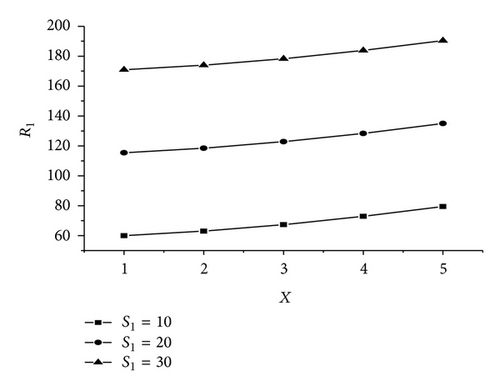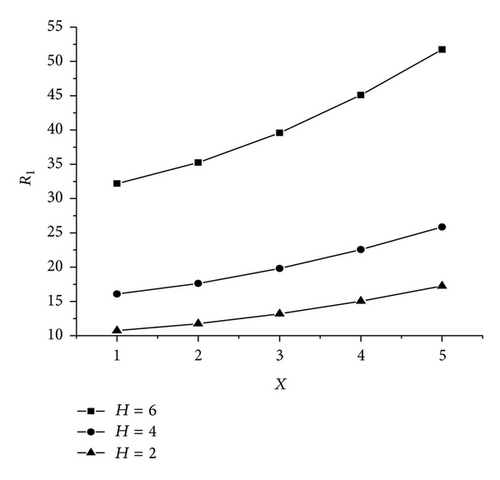Double-Diffusive Convection in Presence of Compressible Rivlin-Ericksen Fluid with Fine Dust
Abstract
An investigation is made on the effect of suspended particles (fine dust) on double-diffusive convection of a compressible Rivlin-Ericksen elastico-viscous fluid. The perturbation equations are analyzed in terms of normal modes after linearizing the relevant set of equations. A dispersion relation governing the effects of viscoelasticity, compressibility, stable solute gradient, and suspended particles is derived. For stationary convection, Rivlin-Ericksen fluid behaves like an ordinary Newtonian fluid due to the vanishing of the viscoelastic parameter. The stable solute gradient compressibility has a stabilizing effect on the system whereas suspended particles hasten the onset of thermosolutal instability. The Rayleigh numbers and the wave numbers of the associated disturbances for the onset of instability as stationary convection are obtained and the behaviour of various parameters on Rayleigh numbers has been depicted graphically. It has been observed that oscillatory modes are introduced due to the presence of viscoelasticity, suspended particles, and stable solute gradient which were not existing in the absence of these parameters.
1. Introduction
A layer of Newtonian fluid heated from below, under varying assumptions of hydrodynamics, has been treated in detail by Chandrasekhar [1]. Chandra [2] performed careful experiments in an air layer and found contradiction between the theory and the experiment. He found that the instability depended on the depth of the layer. A Bénard-type cellular convection with fluid descending at the cell centre was observed when predicted gradients were imposed, if the layer depth was more than 10 mm. But if the layer of depth was less than 7 mm, convection occurred at much lower gradients than predicted and appeared as irregular strips of elongated cells with fluid rising at the centre. Chandra called this motion columnar instability. The effect of particle mass and heat capacity on the onset of Bénard convection has been considered by Scanlon and Segel [3]. They found that the critical Rayleigh number was reduced solely because the heat capacity of the clean gas was supplemented by that of the particles. The effect of suspended particles was found to destabilize the layer. Palniswamy and purushotham [4] have considered the stability of shear flow of stratified fluids with fine dust and have found the effect of fine dust to increase the region of instability. A study of double-diffusive convection with fine dust has been made by Sharma and Rani [5]. Kumar et al. [6] have studied effect of magnetic field on thermal instability of rotating Rivlin-Ericksen viscoelastic fluid, in which effect of magnetic field has stabilizing as well as destabilizing effect on the system. Also, Rayleigh-Taylor instability of Rivlin-Ericksen elastico-viscous fluid through porous medium has been considered by Sharma et al. [7]. They have studied the stability aspects of the system. The effects of a uniform horizontal magnetic field and a uniform rotation on the problem have also been considered separately. Kumar [8] has also studied the stability of superposed viscous-viscoelastic Rivlin-Ericksen fluids in presence of suspended particles through a porous medium. In one other study, Kumar and Singh [9] have studied the stability of superposed viscous-viscoelastic fluids through porous medium, in which effects of uniform horizontal magnetic field and a uniform rotation are considered. Kumar et al. [10] have also studied hyderodynamic and hyderomagnetic stability of Rivlin-Ericksen fluid and found that the growth rates decrease as well as increase with the increase in kinematic viscosity and kinematic viscoelasticity in absence and presence of magnetic field. Singh and Gupta [11] have studied thermal instability of Rivlin-Ericksen elastico viscous fluid permeated with suspended particles in hydrodynamics in a porous medium and found that magnetic field has only stabilizing effect whereas medium permeability has a destabilizing effect on the system. EI-Sayed et al. [12] have studied nonlinear Kelvin-Helmholtz instability of Rivlin-Ericksen viscoelastic electrified fluid particle mixtures saturating porous medium and, in one another study, Kumar and Mohan [13] have also studied double-diffusive convection in compressible viscoelastic fluid through Brinkman porous media.
The present paper attempts to study the stability of double-diffusive convection Rivlin-Ericksen elastico-viscous fluids permeated with suspended particles. Viscosity is a function of space and time in a large variety of fluid flows, and its variation can have a dramatic effect on flow stability. In this paper, instability due to double-diffusive effects in viscosity permeated with suspended particles flow has been discussed. Double-diffusive systems are known to display a rich variety of instability behavior in density permeated with suspended particles fluid flow system. In viscosity permeated systems, it was found that stable flow in the context of single component systems becomes unstable due to double-diffusive effect. Many interesting flow patterns arise due to this instability; these aspects form the motivation for the present study.
2. Formulation of the Problem and Perturbation Equations
We have considered an infinite, horizontal, and compressible electrically conducting Rivlin-Ericksen elastico-viscous fluid permeated with suspended particles, bounded by the planes z = 0 and z = d. This layer is heated from below so that temperature at bottom (at z = 0) and at the upper layer (at z = d) is T0 and Td, respectively, and that a steady adverse temperature gradient β( = |dT/dz|) and solute gradient β′( = |dC/dz|) are maintained. Here, denotes the acceleration due to gravity. The effect of fluid compressibility, even small in magnitude, is also considered.
Also, h = f(Cpt/Cv), , f = mN0/ρm, and G = Cpβ/g.
Initially, , , T = T(z), and N = N0, so, (4) yields 0 = 0, identically.
3. The Dispersion Relation
Equation (24) is the required dispersion relation studying the effects of suspended particles and compressibility on the thermosolutal convection in Rivlin-Ericksen elastico- viscous fluid.
4. The Stability of the System and Oscillatory Modes
Here, we examine whether the instability can occur as oscillatory modes, if any, on the Rivlin-Ericksen elastico-viscous fluid in the presence of compressibility and suspended particles effects.
Equation (28) implies that σi = 0 or σi ≠ 0, which mean that modes may be nonoscillatory or oscillatory. The oscillatory modes are introduced due to presence of stable solute gradient, which were nonexistent in its absence.
5. The Stationary Convection
To study the effect of stable solute gradient and suspended particles, we examine the behaviour of dR1/dS1 and dR1/dH analytically.

In Figure 1, as value of stable solute gradient parameter increased, the value of Rayleigh number is increased by taking values of wave number x( = 1,2, 3,4, 5), for fixed values G = 9.8, H = 2, H′ = 10, and S1( = 10, 20, 30), respectively. Therefore value of Rayleigh number increased with the increase in wave number showing the stabilizing effect on the system.
In Figure 2, Rayleigh number decreased with the increase in the suspended particles by taking values of wave number x( = 1, 2, 3, 4, 5), for fixed values G = 9.8, S1 = 10, H′ = 5, and H( = 2, 4, 6), respectively. Therefore values of Rayleigh number have increased with the decrease of suspended particles parameter, showing the destabilizing effect on the system.

6. Conclusion
Combined effect of various parameters, that is, compressibility, suspended particles, and stable solute gradient, has been investigated on thermosolutal convection of a Rivlin-Ericksen fluid. The motivation for the present study is due to the fact thata fluid-particle mixture is not commensurate with their scientific and industrial importance. The analysis would be relevant to the stability of some polymer solutions and the problem finds its usefulness in several Geophysical situations and in chemical technology. Hence, a study has been made on thermosolutal convection in presence of compressible fluid with fine dust. For stationary convection, Rivlin-Ericksen fluid behaves like an ordinary Newtonian fluid due to the vanishing of the viscoelastic parameter. From (32), it is clear that the effect of compressibility is to postpone the onset of instability. To investigate the effects of suspended particles and stable solute gradient, we examined the expressions dR1/dH and dR1/dS1 analytically. Stable solute gradient postpones the onset of instability whereas suspended particles are found to hasten the onset of instability. These results are graphically verified by Figures 1 and 2, respectively. The oscillatory modes are introduced due to the presence of viscoelasticity, suspended particles, and stable solute gradient. In the absence of these, the principle of exchange of stabilities is found to hold good.
Conflict of Interests
The authors declare that there is no conflict of interests regarding the publication of this paper.
Acknowledgment
The authors are thankful to the chief editor and learned referee for his useful technical comments and valuable suggestions, which led to a significant improvement of the paper.




